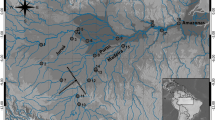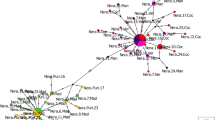Abstract
The rock bream, Oplegnathus fasciatus, is a common rocky reef game fish in East Asia and recently has become an aquaculture species. Despite its commercial importance, the population genetic structure of this fish species remains poorly understood. In this study, 163 specimens were collected from 6 localities along the coastal waters of Korea and China and their genetic variation was analyzed with mtDNA COI sequences. A total of 34 polymorphic sites were detected which determined 30 haplotypes. The genetic pattern reveals a low level of nucleotide diversity (0.04 ± 0.003) but a high level of haplotype diversity (0.83 ± 0.02). The 30 haplotypes are divided into two major genealogical clades: one that consists of only Zhoushan (ZS, East China Sea) specific haplotypes from the southern East China Sea and the other that consists of the remaining haplotypes from the northern East China Sea, Yellow Sea, Korea Strait, and East Sea/Sea of Japan. The two clades are separated by approximately 330~435 kyBP. Analyses of AMOVA and Fst show a significant population differentiation between the ZS sample and the other ones, corroborating separation of the two genealogical clades. Larval dispersal and the fresh Yangtze River plume are invoked as the main determining factors for this population genetic structure of O. fasciatus. Neutrality tests and mismatch distribution analyses indicate late Pleistocene population expansion along the coastal waters of Korea and China approximately 133–183 kyBP during which there were periodic cycles of glaciations and deglaciations. Such population information needs to be taken into account when stock enhancement and conservation measures are implemented for this fisheries species.
Similar content being viewed by others
References
An HS, Hong SW (2008) Genetic diversity of rock bream Oplegnathus fasciatus in Southern Korea. Genes Genom 30(5):451–459
Beardsley RC, Limeburner R, Yu H, Cannon GA (1985) Discharge of the Changjiang (Yangtze River) into the East China Sea. Cont Shelf Res 4:57–76
Bond G, Shower W, Chesby M, Lotti R, Almasi P, DeMenocal P, Priore P, Cullen H, Hajdas I, Bonani G (1997) A pervasive millennial- scale cycle in North Atlantic Holocene and glacial climates. Science 278:1257–1266
Chang KM, Mao JP, Wu JF, Zhang KJ (2005) Study on the embryo and larvae fish development of Oplegnathus fasciatus. J Shang Fish Univ 14:401–405
Clement M, Posada D, Crandall KA (2000) TCS: a computer program to estimate gene genealogies. Mol Ecol 9:1657–1659
Dong YW, Wang HS, Han GD, Ke CH, Zhan X, Nakano T, Williams GA (2012) The impact of Yangtze River discharge, ocean currents and historical events on the biogeographic pattern of Cellana toreuma along the China coast. PLoS One 7(4):e36178
Excoffier L, Lischer HEL (2010) Arlequin suite ver 3.5: a new series of programs to perform population genetics analyses under Linux and Windows. Mol Ecol Resour 10:564–567
Fu YX (1997) Statistical tests of neutrality of mutations against population growth, hitchhiking and background selection. Genetics 147:915–925
Habib KA, Jeong D, Myoung JG, Lee YH (2015) Population panmixia and the Pleistocene demographic expansion of spotty belly greenling Hexagrammos agrammus in the East Sea and Northwest Pacific. Ocean Sci J 50(2):143–154
Habib KA, Jeong D, Myoung JG, Kim MS, Jang YS, Shim JS, Lee YH (2011) Population genetic structure and demographic history of the fat greenling Hexagrammos otakii. Genes Genom 33(4):413–423
Han ZQ, Gao TX, Yanagimoto T, Sakurai Y (2008) Genetic population structure of Nibea albiflora in Yellow Sea and East China Sea. Fisheries Sci 74(3):544–552
Han ZQ, Lin LS, Shui BN, Gao TX (2009) Genetic diversity of small yellow croaker Larimichthys polyactis revealed by AFLP markers. Afr J Agric Res 4(7):605–610
Hewitt GM (2000) The genetic legacy of the Quaternary ice ages. Nature 405:907–913
Huelsenbeck JP, Ronquist F (2001) MrBayes: Bayesian inference of phylogenetic trees. Bioinformatics 17:754–755
Imbrie J, Boyle EA, Clemens SC, DuVy A, Howard WR, Kukla G, Kutzbach J, Martinson DG, McIntyre A, Mix AC (1992) On the structure and origin of major glaciation cycles, 1. linear responses to Milankovitch forcing. Paleoceanography 7:701–738
Jung SJ, Oh MJ (2000) Iridovirus-like infection associated with high mortalities of striped beakperch, Oplegnathus fasciatus (Temminck et Schlegel), in southern coastal areas of the Korean peninsula. J Fish Dis 23:223–226
Jiang M, Shen XQ, Chen LF (2006) Relationship between with abundance distribution of fish eggs, larvae and environmental factors in the Changjiang Estuary and vicinity waters in spring. Mar Environ Sci 25(2):37–39
Kearse M, Moir R, Wilson A, Stones-Havas S, Cheung M, Sturrock S, Buxton S, Cooper A, Markowitz S, Duran C, Thierer T, Ashton B, Mentjies, P, Drummond, A (2012) Geneious Basic: an integrated and extendable desktop software platform for the organization and analysis of sequence data. Bioinformatics 28(12):1647–1649
Kim JK, Bae SE, Lee SJ, Yoon MG (2017) New insight into hybridization and unidirectional introgression between Ammodytes japonicus and Ammodytes heian (Trachiniformes, Ammodytidae). PLoS One 12(6):e01780001
Kinoshita I, Seikai T, Tanaka M, Kuwamura K (2000) Geographic variations in dorsal and anal ray counts of juvenile Japanese Flounder, Paralichthys olivaceus in the Japan Sea. Environ Biol Fish 57:305–313
Kumar S, Koichiro T, Ingrid BJ, Masatoshi N (2001) MEGA: Molecular Evolutionary Genetics Analysis software. Bioinformatics 17(12):1244–1245
Lambeck K, Esat TM, Potter EK (2002) Links between climate and sea levels for the past three million years. Nature 419:199–206
Lie HJ, Cho CH, Lee JH, Lee S (2003) Structure and eastward extension of the Changjiang River plume in the East China Sea. J Geophys Res-Oceans 108(C3):3077
Lim SJ, Lee KJ (2009) Partial replacement of fish meal by cottonseed meal and soybean meal with iron and phytase supplementation for parrot fish, Oplegnathus fasciatus. Aquaculture 290:283–289
Lipton DW, Kim DH (2007) Assessing the economic viability of offshore aquaculture in Korea: an evaluation based on rock bream, Oplegnathus fasciatus, production. J World Aquacult Soc 38(4):506–515
Liu JX, Gao TX, Zhuang ZM, Jin XS, Yokogawa K, Zhang YP (2006) Late Pleistocene divergence and subsequent population expansion of two closely related fish species, Japanese anchovy (Engraulis japonicus) and Australian anchovy (Engraulis australis). Mol Phylogenet Evol 40(3):712–723
Liu XZ, Xu YJ, Wang YY, Lu YQ, Qu JZ (2008) Characters of development and growth of early life stages of the rock bream Oplegnathus fasciatus. Acta Zool Sinica 54:332–341
Mundy BC (2005) Checklist of the fishes of the Hawaiian Archipelago. Bishop Museum Press, Honolulu, 704 p
Myoung SH, Kim JK (2014) Genetic diversity and population structure of the gizzard shad, Konosirus punctatus (Clupeidae, Pisces), in Korean waters based on mitochondrial DNA control region. Genes Genom 36:591–598
Nei M (1987) Molecular evolutionary genetics. Columbia University Press, New York, 512 p
Neigel JE (1994) Analysis of rapidly evolving molecules and DNA sequence variants: alternative approaches for detecting genetic structure in marine populations. Cal Coop Ocean Fish 35:82–89
Nohara K, Takeuchi H, Tsuzaki T, Suzuki N, Tominaga O, Seikai T (2010) Genetic variability and stock structure of red tilefish Branchiostegus japonicus inferred from mtDNA sequence analysis. Fisheries Sci 76(1):75–81
Petit JR, Jouzel J, Raynaud D, Barkov NI, Barnola JM, Basile I, Bender M, Chappellaz J, Davis M, Delaygue G (1999) Climate and atmospheric history of the past 420,000 years from the Vostoc ice core, Antarctica. Nature 399:429–436
Posada D, Crandall KA (1998) Modeltest: testing the model of DNA substitution. Bioinformatics 14:817–818
Quan HF, Xiao ZZ (2007) Research on the technique for artificial breeding of Oplegnathus fasciatus. J Oceanorgr Taiwan Strait 26:295–300
Rocha LA, Bass AL, Robertson DR, Bowen BW (2002) Adult habitat preferences, larval dispersal, and the comparative phylogeography of three Atlantic surgeon fishes (Teleostei: Acanthuridae). Mol Ecol 11(2):243–251
Rogers AR, Harpending H (1992) Population growth makes waves in the distribution of pairwise genetic difference. Mol Biol Evol 9:552–569
Safran P (1990) Drifting seaweed and associated ichthyofauna: floating nursery in the Tohoku waters. La Mer 28(4):225–239
Schembri, PJ, Bodilis P, Evans J, Francour P (2010) Occurrence of barred knifejaw, Oplegnathus fasciatus (Actinopterygii: Perciformes: Oplegnathidae), in Malta (Central Mediterranean) with a discussion on possible modes of entry. Acta Ichthyol Piscat 40(2):101–104
Shan XJ, Quan HF, Dou SZ (2008) Effects of delayed first feeding on growth and survival of rock bream Oplegnathus fasciatus larvae. Aquaculture 277:14–23
Shirai SM, Kuranaga R, Sugiyama H, Higuchi M (2006) Population structure of the sailfin sandfish, Arctoscopus japonicas (Trichodontidae), in the Sea of Japan. Ichthyol Res 53:357–368
Shui BN, Han ZQ, Gao TX, Miao ZQ (2008) Genetic structure of Japanese Spanish mackerel (Scomberomorus niponius) in the East China Sea and Yellow Sea inferred from AFLP data. Afr J Biotechnol 7:3860–3865
Sun P, Li J, Yi F, Pen SM, Liu MH, Shi ZH (2011) Genetic variation of mitochondrial control region sequences in cultured Oplegnathus fasciatus. Mar Fish 33:9–14
Tajima F (1983) Evolutionary relationship of DNA sequence in finite populations. Genetics 105:437–460
Tajima F (1989) Statistical method for testing the neutral mutation hypothesis by DNA polymorphism. Genetics 123:585–595
Tsuchida S, Tabata S (1997) Changes of the preferred temperature in striped beakperch, Oplegnathus fasciatus, during the juvenile growth. B Jpn Soc Sci Fish 63(1):64–69
Vitas AP, Jun HR, Byung HM, Rudhy G, Young JC (2016) Effects of different salinity levels on blood properties of rock bream Oplegnathus fasciatus. Indones Aquac J 11(2):75–79
Wang XJ, Kim KW, Bai SC, Huh MD, Cho BY (2003) Effects of the different levels of dietary vitamin C on growth and tissue ascorbic acid changes in parrot fish (Oplegnathus fasciatus). Aquaculture 215:203–211
Ward LK, Clarke RT, Cooke AS (1994) Long-term scrub succession deflected by fallow deer at Castor Hanglands National Nature Reserve. Ann Rep Inst Terre Ecol 1993–4:78–81
Xiao ZZ, Zheng J, Yu DD, Li J (2008) Developmental characters at the early stages of the Japanese Parrotfish (Oplegnathus fasciatus). Mar Sci 32:25–30
Xiao Y, Li J, Ren G, Ma D, Wang Y, Xiao Z, Xu S (2016) Pronounced population genetic differentiation in the rock bream Oplegnathus fasciatus inferred from mitochondrial DNA sequences. Mitochondrial DNA A DNA Mapp Seq Anal 27(3):2045–2052
Xiao ZZ, Xiao YS, Ren GJ, Gao TX, Tu DZ, Han ZQ, Li J (2013) Comparative analysis on the genetic variation of cultured and wild rock bream Oplegnathus fasciatus population based on mtDNA control region. Oceanol Limnol Sin 44:249–254
Xu T, Shao C, Liao X, Ji X, Chen S (2009) Isolation and characterization of polymorphic microsatellite DNA markers in the rock bream (Oplegnathus fasciatus). Conserv Genet 10(3):527–529
Yoshikoshi K, Inoue K (1990) Viral nervous necrosis in hatcheryreared larvae and juveniles of Japanese parrotfish, Oplegnathus fasciatus (Temminck et Schlegel). J Fish Dis 13:69–77
Author information
Authors and Affiliations
Corresponding author
Rights and permissions
About this article
Cite this article
Park, H.S., Kim, CG., Kim, S. et al. Population Genetic Structure of Rock Bream (Oplegnathus fasciatus Temminck & Schlegel, 1884) Revealed by mtDNA COI Sequence in Korea and China. Ocean Sci. J. 53, 261–274 (2018). https://doi.org/10.1007/s12601-018-0009-z
Received:
Revised:
Accepted:
Published:
Issue Date:
DOI: https://doi.org/10.1007/s12601-018-0009-z




